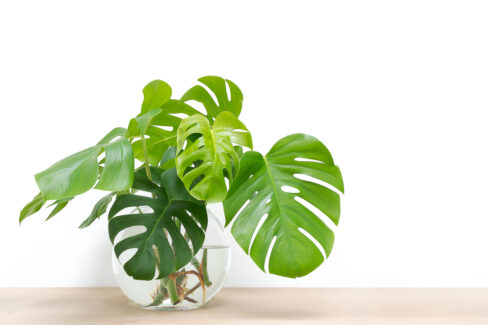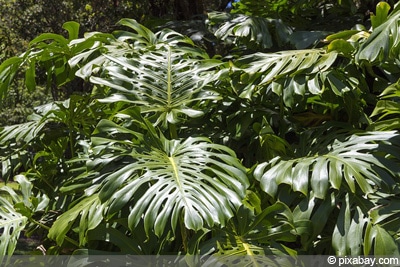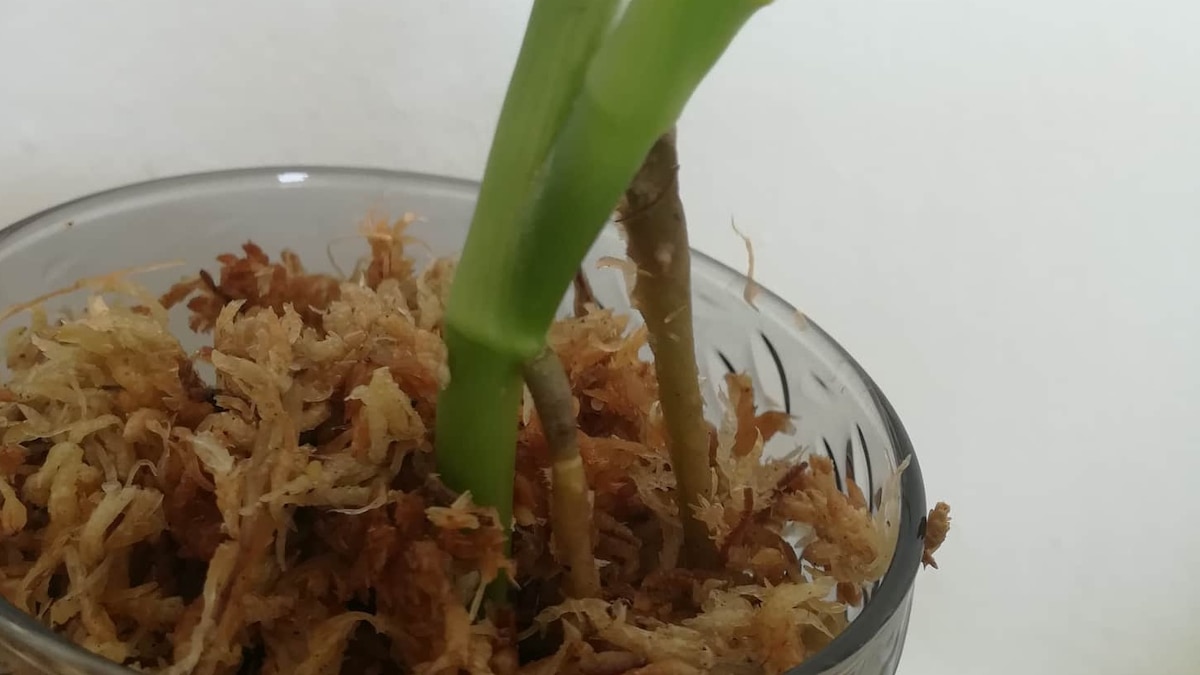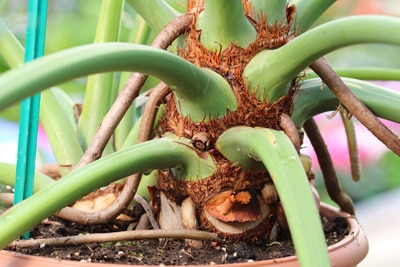Contents
- 1 Propagate Philodendron – A step by step guide to taking cuttings.
- 2 Step 1: Cut and prepare philodendron cuttings.
- 3 Step 2: Pot up the Philodendron cuttings and then care for them.
- 4 Step 3: Repot philodendron cuttings
- 5 Cut offshoots and prepare – Here’s how
- 6 Potting and caring for cuttings – What you should pay attention to
- 7 Tips
- 8 Philodendron: quick and easy propagation
- 9 The philodendron – a plant genus that loves to grow
- 10 Caution, the philodendron is poisonous
- 11 Philodendron species
- 12 Care of the Philodendron
- 13 Pruning the Philodendron
- 14 Conclusion
- 15 Author
Propagate Philodendron – A step by step guide to taking cuttings.
Philodendrons are not only a tree friend to the jungle giants, but also offer gardeners with their uncomplicated care requirements a welcome cultivation option. These advantages are also evident in the propagation of the evergreen houseplant: we show you how to easily and quickly take cuttings from the philodendron.

Step 1: Cut and prepare philodendron cuttings.
If the early summer month of May arrives, it is high time to propagate the tree friend. The easiest way to propagate the evergreen exotic is to take cuttings. Primarily all climbing species of philodendron are most suitable for the cutting method.
Cut off one or more tips of a shoot from your philodendron with an approximate length of 10 to 15 cm. Remove all leaves from these shoot tips, which could later come into contact with the growing medium. However, leave at least one leaf per cutting at the tip.
Step 2: Pot up the Philodendron cuttings and then care for them.
For your cutting, you should first prepare small growing pots, which have holes in the bottom: To do this, fill the pots with a mixture of coconut fiber and lava granules. If you have taken small-leaved philodendron offshoots from the mother plant, you can plant several of the specimens in one pot to save space. Large-leaf cuttings, however, should be placed individually in the growing container.
This is the best way to proceed:
Moisten the growing medium with soft, lime-free water.
Insert a cutting halfway or up to two-thirds into the soil.
Now add several wooden sticks as spacers.
Finally, place a plastic bag over the seed pot.
Place the cuttings in a bright, slightly sunny location at normal room temperature.
Now air the hood daily and in the course of this also slightly moisten the soil without causing waterlogging. After about a month, a fresh leaf will develop on the cutting: from this point on, the plastic bag has done its job and can be removed from the pot.
Extra tip: In addition, after these four weeks, you can provide the small cutting with liquid fertilizer (half concentration) at intervals of 21 to 30 days.
Step 3: Repot philodendron cuttings
After 6 months, the small cuttings will have matured enough to move to a new pot. Now the philodendron young plants take a place in nutrient-rich, acidic soil and can be treated like adult plants from now on.
Philodendron is not only considered a tree friend, but also friendly to its gardener with uncomplicated care requirements. Moreover, its advantages come into their own when you want to grow more copies of the evergreen houseplant. How to do it with a cuttings, explains this tutorial.
Cut offshoots and prepare – Here’s how
Early summer is the best time to propagate a tree friend. It is mainly the climbing Philodendron species that are suitable for the cutting method. Cut off one or more shoot tips 10 to 15 inches long. Remove any leaves that may later come into contact with substrate. At least one leaf should remain at the tip of each cutting.
Potting and caring for cuttings – What you should pay attention to
Prepare pots with bottom holes for your cuttings, which you fill with a mix of coconut fibers and lava granules Please put a large-leaved Philodendron cuttings individually into the pot. Small-leaved cuttings can be potted with several specimens to save space. Proceed as follows:
- Moisten the substrate with lime-free water.
- Place a cutting half to two-thirds into the growing medium
- Insert several wooden sticks as spacers and put a plastic bag over it
In the bright, not full sun location with normal room temperatures rooting progresses rapidly. Air the hood daily and moisten the soil without causing waterlogging. When a fresh leaf develops after 4 weeks, the plastic bag has done its job and can be removed. From this point, fertilize the offshoots with liquid fertilizer in half concentration at intervals of 3 to 4 weeks.
After an average of 6 months, a tree friend cutting will be mature enough to be repotted. The small-leaved cuttings are not separated, but take their place together in the nutrient-rich, acidic plant soil. From now on, care for your offspring as you would adult philodendrons.
Tips
Propagate the rare, non-climbing species, such as Philodendron bipinnatifidum, by seed. Unless your tree friend flowers and fruits, you can get certified seeds at specialty stores. Put the white seeds 1 cm deep in coconut fiber substrate and maintain them at 23 to 25 degrees Celsius in a semi-shaded location. Under ideal conditions, germination time is between 2 and 6 weeks.

Philodendron: quick and easy propagation
Whether Philodendron Scandens, Xanadu or Monstera: The diverse plant family is considered particularly easy to care for and is uncomplicated to propagate. You can use a beautiful offshoot, for example, as a particularly creative and sustainable gift. In this practical tip, we show you two ways to propagate your philodendron:
- Choose offshoots: The philodendron plant should ideally be older when you take a cutting. The shoot should be about 10 to 15 inches tall. It is important that you cut it off below a leaf node with a straight cut. This way you will not damage the mother plant.
- Option 1: Smaller offshoots grow best in sphagnum moss. You will also need a jar in which the offshoot will fit and warm water. Soak the moss in the water. Before placing the offshoot in the moss, make sure it is not too moist.
- In a room-warm, not full sun location, philodendron offshoots rooted in moss will need about 4 to 6 weeks before you can set them in houseplant soil. The moss will need regular spraying during this time. The roots should be well branched and strong before potting, then the offshoot is ready to be repotted.

Propagate aerial roots of philodendron as offshoots.
Besides the first way just mentioned to propagate your philodendron plant, there is another:
- You can also simply root vigorous offshoots, ideally with large aerial roots, in a large container of warm water.
- It will then take about 8 weeks before you can plant the offshoot. During this time, the leaves should be sprayed regularly.
The philodendron – a plant genus that loves to grow
The jungle in the living room with little care and little work need not remain a dream, you just need to put a few philodendrons and let them grow. More precisely, a philodendron, because the tree friend is so easy to maintain and propagate that even with this one philodendron you will very quickly get your living room jungle.
Philodendrons (also called tree friends), are a genus of plants in the arum family. They are evergreen herbaceous plants, root climbers that can also grow epiphytically, or bushy growing plants. They can grow up to 6 m tall and have mostly evolved in rainforests, in tropical America and the Caribbean.
The leaves offer a rich variety of different shapes, and not only because of this decorative variety, the tree friends are among our most popular ornamental plants. They are very well suited as houseplants, are indestructible even for beginners, are generally undemanding to keep, and usually only become a problem when they outgrow their “keepers” (which can be quickly changed, see below).
Because the Philodendron wants to be sprayed with water more often, it also makes the dry heating air more bearable for us humans, especially in winter. In addition, it also cleans the air for us, it is very good at filtering or absorbing harmful formaldehyde (toxic chemical, e.g. in paints, disinfectants and cosmetics), carbon monoxide (e.g. in exhaust fumes) and benzene (e.g. in exhaust fumes) from the air and making them harmless.
Caution, the philodendron is poisonous
Or rather, “eat philodendron”, all the plants of the genus should not be able to be nibbled by small children or pets, and when caring for them, even adult indoor gardeners should be careful: The plants contain a wide variety of toxic substances that science has not yet been able to name precisely; they are usually referred to simply as “pungents.” However, it is certain that the philodendrons contain calcium oxalate crystals and soluble salts of oxalic acid, so contact with the sap can quickly cause skin irritation.
And as nice as it is to have found a location for your philodendron where it develops one bloom after another at intervals of a few months, it could be annoying for people with sensitive noses: The flowers of most Philodendron varieties smell quite distinctly of carrion, which insects now find really tasty, and they are supposed to be encouraged to pollinate by the scent. Some Philodendron species can also generate very high temperatures, they heat the inside of their flowers through certain plant cells that function like batteries to over forty degrees, can thus the scents of their flowers even better and attract even more insects – in the living room but then it stinks a bit.
Philodendron species
In total there are something between 450 and 620 Philodendron species. However, only a few representatives of the species are offered to you in the trade as houseplants, because they can stand it to some extent even in our latitudes. Here are some common indoor philodendrons and their requirements:
- Probably our most common philodendron is the climbing philodendron Philodendron hederaceum, commercially known by the synonym Philodendron scandens, which is native to Mexico and tropical America. It has thick and leathery leaves that are somewhere between flattened hearts and eggs in shape, and can climb up trellises and moss poles. It prefers to be in partial shade, but will tolerate shade (but not full sun), likes temperatures around 20 degrees in the summer, and can be kept cooler in the winter, but not below 15 degrees.
- Philodendron elegans is a climbing species with long tendrils that form leaves that look a bit frayed, there is a larger gap between each part of the leaf. The whole plant looks very space-consuming and distinguished due to the generous leaf shape.
- Quite well known is also the “Ausgefranste Baumfreund”, the Philodendron laciniatum, which is also sold under the synonym P. pedatum. It forms strong round leaf stems, is considered very hardy, and develops leaves that are basically tripartite, but very variable in shape. This philodendron tolerates a little more light than its colleagues, in a too dark place its leaves develop in only small size and not in the typical shape.
- Small-leaved philodendron, or Philodendron grazielae, has evolved in Peru and Brazil, where it is a climbing plant several meters long that canopies rainforest trees. It has heart-shaped leaves that grow up to 5 cm wide, shiny dark green and close together on the tendrils.

Overall, these species are rather not so demanding in terms of temperatures, especially tolerate a cool location in the winter. So these are suitable tree friends for a winter kept cooler winter garden. Somewhat warmer, even in winter, like the following species, in winter it should not be colder than 18 degrees for their taste. So they are the right philodendrons for year-round living room keeping:
- Philodendron bipennifolium is a hardy climbing species from southern Brazil that develops elongated heart-shaped to anchor-like, glossy dark green leaves. Depending on the light intensity to which the plant is exposed, the leaf shape will change slightly.
- Also known as tree love, Philodendron erubescens is a well-known climbing plant native to Colombia. It develops a greenish to red stem, dark green leaves above and reddish below, and sometimes deep pink tinted bracts. The cultivar “Green Emerald” is usually used, but variegated varieties are also available.
Philodendron melanochrysum, also known by the synonym P. andreanum, also comes from Colombia and also climbs, but develops somewhat lighter green leaves when young, later turning bronze green with striped accents.
Of course, these were far from all the tree friends that can be cultivated in our country, you can also look at the varieties Philodendron bipinnatifidum or selloum, P. gloriosum, P. impolitum, P. radiatum, P. rugosum, P. sagittifolium, P. squamiferum, P. stenolobum × selloum, P. tuxtlanum, and P. warszewiczii, you are sure to find the philodendron that has just the right leaf shape and color, growth habit and size, and ambient temperature requirements for you.
If you are now missing in all the descriptions exactly the plant that you previously thought was a philodendron, it is because the window leaves or monstera are also often traded as philodendrons. When they first began to be sold in our country, some monsteras were still called philodendrons, for example the “Monstera adansonii”, which at that time had the botanical name “Philodendron pertusum”. This has subsequently changed, and now the genus Philodendron and the genus Monstera are considered separate subfamilies of the Arum family.
Care of the Philodendron
Except for the fine extra wishes of the individual species, all tree friends want the same care: they all come from tropical rainforests, and in these there are quite specific conditions that they would like to have recreated as well as possible in our country – at least if they are to thrive so well.
First of all, in the rainforest there is a very nutritious, but well water-permeable soil, so the philodendrons would like to be placed in a very nutrient-rich humus soil in our country as well. Temperatures in South America are consistent throughout the year, with a clear preponderance of temperatures above 20 degrees and never (except for mountain tops) below zero, so the philodendrons would like it warm rather than cool in our area as well.
In the rainforest they grow almost completely in the shade, only the uppermost branches stretch into the light in the treetops, and so the philodendrons tolerate a somewhat shadier place here as well. With emphasis on a little, the light intensity in Europe is really not comparable with that in South America (much worse, much further from the equator). That’s why Philodendrons can be kept in bright to half-shady places, and don’t like direct sunlight, but are only satisfied with really dark places in absolutely exceptional cases – those are then probably the species that creep along the ground in the rainforest, but then you would have to be informed about this growth form.
What there is of course in abundance in the rainforest is moisture, that’s why it’s called that. So: a Philodendron wants soil that is always slightly moist, and that is probably the hardest part of keeping it. After all, “slightly moist” doesn’t mean “wet,” and a great many amateur gardeners mean so well with watering their favorites that they almost manage to drown aquatic plants. Philodendrons, too, should always be watered again only when the soil on top has dried out, and they really don’t like waterlogging at all. If you want to see blooms (despite possible “odor hazards”), you should even keep your philodendron extra tight for a while during the winter time – plants are different from us in this respect, without fear of extinction, reproduction is gladly put on the back burner …
Otherwise, a philodendron is also used to a lot of moisture in the air around it, so much moisture that in your living room the wallpaper would fall off the walls. As a substitute, you can regularly spray the leaves with a water sprayer, or spray the leaves with a damp cloth, this will at least partially replace the lack of humidity in the air for the plant and also keep the leaves always nice and shiny.
In the rainforest, growth takes place at a completely different speed than in the European fields, and the philodendrons also like to “turbo-grow” here – but only if you provide them with the appropriate nutrition in the form of regular full fertilizer applications, during the growth phase in summer every 2 weeks, in winter they still get some green plant fertilizer once a month.
Pruning the Philodendron
Cut philodendron? No question, no problem and no need to think. If you’re used as a monkey swing in the rainforest more often than not, you’re used to losing a shoot now and then … No, seriously, you can cut back a philodendron however and wherever you like. Feel free to cut right through the middle, too; both the part you cut off and what’s left will resprout (the part you cut off only if you put it in soil, of course).
You can also cut away several individual parts, all these parts can be used right away as cuttings for propagation. The tops can be planted directly, stem or stalk parts are simply cut into round hand length pieces and put into growing soil)with one part in the air), they will all develop into new plant.
However, what you should not cut away are the aerial roots, because they urgently belong to the philodendron. With them, the philodendrons absorb nutrients in the same way as with the root in the ground. The aerial roots make it easier for them to transfer these nutrients to the upper parts of the plant, and they can absorb moisture from the environment with the aerial roots, so aerial roots are anything but superfluous.
Conclusion
If you like lots of greenery around you and clean air without putting too much work into caring for houseplants, a philodendron is just the plant for you. Philodendrons are offered in so many species that “your” philodendron could even fulfill special design wishes.

